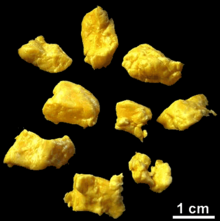Curd
![]()
This article or subsequent section is not sufficiently supported by evidence (e.g., anecdotal evidence). Information without sufficient evidence may be removed in the near future. Please help Wikipedia by researching the information and adding good supporting evidence.
Curd (or curd) is the term used in cheesemaking to describe the material produced from milk that has been thickened by the addition of rennet or lactic acid (called curd) after it has been cut up (broken) to separate the whey. There are different methods for doing this, depending on the type of cheese: First, the curd is cut to allow the whey to drain away, only coarsely for soft cheeses (more whey remains in the curd) and progressively finer the firmer the cheese is to be. For hard cheese, the curd is repeatedly cut in criss-cross fashion with a cheese harp until it reaches the size of a cherry stone. Additionally, the longer the curd is stirred, the more the curd grain shrinks. Once the curd grains have settled to the bottom of the vat, they grow back together and can be split again, resulting in a crumbly paste.
Cheddaring or chestering refers to a form of curd treatment that is used to achieve a supple, smooth consistency of the cheese. The curd is cut into large blocks which are then stacked and shifted so that the bottom piece is pressed and continues to release whey.
The nature of the fracture can also be changed by heating (firing) the fracture-whey mixture. Raising the temperature causes the curd grain to shrink significantly and become more compact. This results in a firmer cheese that can be stored longer. The firing temperature for cheese ranges from 41 °C to 49 °C or more for Emmentaler. To make scalded cheeses such as mozzarella or provolone, the curd is cut into small pieces and scalded with hot water to form an elastic mass, which is then pressed, kneaded and drawn out into strands. Such kneaded cheese is also called filata cheese.
Depending on the type of cheese, the whey released is skimmed off, made to drain by suspending the curd in a permeable cheesecloth or by layering the curd in baskets or perforated moulds made of wood or stainless steel, or else pressed out of the curd under pressure.

Cheese curd
See also
- Cheese curds
- Lor
Search within the encyclopedia